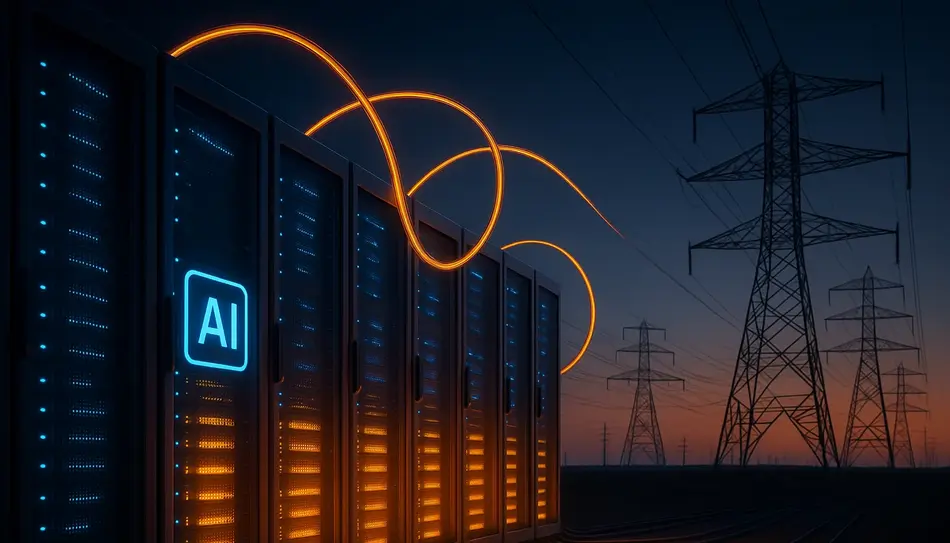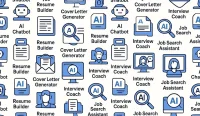The Hidden Energy Crisis Behind AI
The digital revolution has an invisible cost that’s becoming impossible to ignore. As artificial intelligence transforms every aspect of our lives, the massive data centers powering this transformation are consuming staggering amounts of electricity – and reshaping America’s energy landscape in ways that few people realize.
The numbers are staggering: the average ChatGPT request requires almost 10 times more electricity than a simple Google search. This exponential increase in power consumption is happening across more than 2,700 data centers stretching from the suburbs of Virginia to the deserts of the West, consuming over 4% of all electricity in the United States in 2022 alone.
This consumption is projected to more than double to 9% by 2030, creating an unprecedented strain on America’s aging power grid. The nation’s infrastructure, already struggling to meet current demands, faces a critical challenge as artificial intelligence drives exponential growth in data center construction and energy consumption.
Inside the Power-Hungry World of Data Centers
Google’s data center outside Reno, Nevada, offers a glimpse into this hidden world. Inside endless rows of servers and miles of cables – the arteries of the internet – every Google search, every cat video, and every AI interaction flows through these physical locations. Amanda Peterson Coro, Google’s global head of data center energy, explains that hundreds of fans on rooftops are needed just to cool these power-hungry facilities.
The environmental impact is significant. Google’s planet-warming emissions rose by 13% last year and have jumped nearly 50% since 2019. While the company has invested heavily in renewable energy and claims 64% of its operations run on clean energy, the reality is more complex. When the sun isn’t shining and the wind isn’t blowing, data centers still rely on gas and coal, creating more carbon emissions and fueling climate change.
The Renewable Energy Revolution
The solution to this energy crisis may lie deep underground in the desert of southern Utah. Tim Latimer, CEO of Fervo Energy, is drilling 12,200 feet below the surface to harness heat from the Earth’s crust and create carbon-free geothermal energy. Currently, geothermal accounts for less than 1% of US electricity, but Fervo has adapted fracking and drilling techniques from the oil and gas industry to vastly expand geothermal use.
“We think that geothermal could be as much as 20% of the US electricity grid,” Latimer explains. “We can develop large projects that will really move the needle on the electric grid and climate change.” This single site alone could eventually power 400,000 homes, and Google is already a customer, planning to use geothermal energy to help power its Nevada data centers.
The Nuclear Power Renaissance
In Pennsylvania, there’s a dramatic plan to power up a reactor at the site of America’s worst commercial nuclear disaster. The Three Mile Island nuclear plant, where a partial meltdown occurred in 1979, is being revived with a $1.6 billion investment from Constellation Energy. The plant will provide power to Microsoft data centers as part of a 20-year deal, creating thousands of jobs while meeting the growing demand for clean, zero-carbon energy.
Nuclear energy expert Professor Anna Ericson explains why nuclear power is particularly well-suited for AI’s energy demands: “AI requires energy that is 24/7 and nuclear power is one of the best sources to provide that consistent need for energy.” The reactor isn’t expected to be online until 2028, but it represents a significant shift in how we power our digital infrastructure.
The Community Impact of Data Center Boom
The data center boom is transforming communities across America, particularly in Loudoun County, Virginia, home to the highest concentration of data centers in the world. The economic benefits are undeniable – data centers generate a third of the county’s budget while using just 3% of the land, funding new roads, schools, and infrastructure.
However, the transformation comes at a cost. Industrial-strength transmission lines crisscross the county, pushing power consumption up 240% over five years. Ben Keith, who bought a house in 2014 for its bucolic farmland view, now overlooks a data center under construction. “I certainly wouldn’t have paid a lot for you,” he admits when asked if he would buy the property again.
Hiring in the Age of AI?
As AI reshapes America’s energy grid and job market, the demand for top talent is higher than ever. Post your job on WhatJobs and connect with millions of skilled professionals today.
Post a Job Now →The Skilled Trades Crisis
As data centers multiply across the country, a critical labor shortage threatens their operation and maintenance. Brandon Fry, who manages a data center outside Chicago, feels squeezed by soaring demand and shrinking supply of skilled workers. “Everything in here needs servicing,” he explains. “Tech support, HVAC support, electricians.”
The crisis is acute: roughly 400,000 skilled trade jobs are unfilled in America, and by 2033, that number could hit close to 2 million. As older blue-collar workers retire, younger people are choosing college and white-collar jobs over skilled trades, creating a growing labor crisis that affects every industry.
Dan Brown, an experienced HVAC technician, makes more than $150,000 without student debt, but the trades have been neglected for decades. “The trades kind of got neglected,” he explains. “So now there’s a void that needs to be filled.”
Innovative Solutions to the Labor Crisis
Technology is emerging as one solution to the skilled trades shortage. Matt Brereslin, an executive for software company IFS, demonstrates programs that help companies route and reroute their fleet of technicians more efficiently. “When you think about the labor shortages that are out there, and you want to create more efficiencies and do more with less, this is how that’s going to happen.”
Meanwhile, local unions are aggressively recruiting young workers for apprenticeship programs. Electrician Kevin Fishbach sees hope in these efforts: “They come into the trades and they got insurance, they got healthcare, they got a pension.”
The Battery Revolution
In Nevada, an innovative solution is emerging: using recycled electric vehicle batteries to power data centers. Redwood Materials, which already reuses 90% of North America’s lithium-ion waste, is repurposing batteries that have lost only 20% of their capacity. “There’s really very little wrong with them,” explains engineer Colin Campbell. “Maybe your electric vehicle is a little bit slower, but it still works great.”
The system is remarkably simple – no pipes, no pumps – and the company is confident it can scale this solution 100-fold. “We’re showing that AI doesn’t have to be in conflict with the existing grid,” says Redwood founder JB Straubel. “Yesterday’s car batteries powering tomorrow’s computer brains.”
The Future of America’s Digital Infrastructure
The data center energy crisis represents a fundamental challenge for America’s digital future. As AI becomes more integrated into our daily lives, the demand for reliable, clean energy will only increase. The solutions – from geothermal energy to nuclear power to recycled batteries – offer hope, but they require significant investment and innovation.
The skilled trades shortage adds another layer of complexity, threatening the maintenance and operation of these critical facilities. However, the high wages and benefits available in skilled trades, combined with innovative technology solutions, offer a path forward.
Conclusion: Balancing Growth with Sustainability
The data center boom is reshaping America’s energy landscape and job market in ways that few people anticipated. While the economic benefits are significant, the environmental and social costs require careful management. The solutions – from renewable energy to skilled trades recruitment – offer hope for a sustainable digital future.
As we move forward, the key will be balancing the incredible benefits of AI and digital technology with the need for clean energy, skilled workers, and community preservation. The data center energy crisis is not just a technical challenge – it’s a fundamental question about how we want to power our digital future.
Frequently Asked Questions
How much electricity do AI data centers consume compared to regular internet searches?
AI data centers consume almost 10 times more electricity than a typical Google search, with data centers already using 4% of all US electricity and projected to reach 9% by 2030.
What renewable energy solutions are being developed for data centers?
Solutions include geothermal energy from deep underground drilling, nuclear power plants, and innovative battery storage systems using recycled electric vehicle batteries to provide 24/7 clean power.
Why is there a skilled trades shortage affecting data centers?
Roughly 400,000 skilled trade jobs are unfilled in America, with older workers retiring and younger people choosing college over trades, creating a crisis for maintaining data center infrastructure.
How are communities being affected by the data center boom?
While data centers bring economic benefits like tax revenue and jobs, they also transform landscapes with industrial transmission lines, increase power consumption dramatically, and can impact residential areas and property values.
Live Example: A Real-World Impact
Consider the story of Ben Keith in Loudoun County, Virginia, who purchased a home in 2014 for its peaceful farmland view. Today, his neighborhood overlooks a massive data center under construction, one of more than 100 new facilities coming to the area. While the data centers generate significant tax revenue for the county, Keith’s property value and quality of life have been fundamentally altered. “I certainly wouldn’t have paid a lot for you,” he admits when asked if he would buy the property again, illustrating the complex trade-offs communities face between economic development and quality of life.




